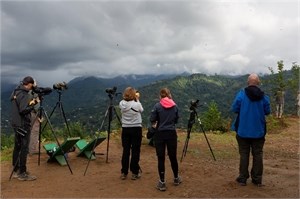Age: More Than Just a Number
Posted on September 30, 2019 in Science

By Zoey Greenberg
This month, the internationally renowned ornithological journal Ibis published a paper lead by Dr. Wouter Vansteelant, a former Hawk Mountain conservation science and leadership trainee. The featured study was conducted at Batumi Raptor Count (BRC), located in the lowlands of Georgia, between the eastern shore of the Black Sea and the Lesser Caucasus. The BRC was established in 2008 by Wouter and another former Hawk Mountain leadership trainee, Johannes Jansen, and has since become an exemplary monitoring site with a unique counting protocol and dedicated team of trained citizen scientists. This qualified crew is responsible for collecting 100% of the data, an impressive feat considering more than a million raptors fly through BRC each year, making it one of the most important raptor migration flyways in the world.
The Batumi Raptor Count spent several years polishing a counting protocol that intentionally prioritizes quality of data over quantity. Rather than recording passage of all 37 raptor species passing by BRC during their movements to and from Eurasia, counters instead focus on eight species. The “chosen ones” are selected for their consistent aggregations at the site and therefore reliable representation of the species’ populations as a whole. These eight species are the European honey buzzard, black kite, booted eagle, short-toed snake eagle, lesser spotted eagle, Montagu’s harrier, pallid harrier, and marsh harrier. A central benefit to this monitoring approach is that by focusing on a select group of species, counters can take the time and attention to reliably record the age and sex of individual birds. This provides a more holistic documentation of the migrant composition for each species. For example, counters can then determine whether or not the majority of marsh harriers are juveniles or adults. These specifics can then lead to more accurate understanding of population trends, as well as predictive conservation action.
The importance of aging migrants became clear during the 1950s at Hawk Mountain. Rachel Carson, author of the famous book Silent Spring, utilized long-term monitoring data from the Sanctuary to make the case that widely-used insecticides were harming bald eagle populations across North America, as well as jeopardizing human health. At the time, Maurice Broun was aging bald eagles as they flew over North Lookout, revealing an alarming trend of fewer juveniles. Although the number of total eagles remained relatively normal, fewer juveniles meant fewer birds breeding in the future and eventually a reduction in overall population. In other words, as adults died off, there weren’t enough younger eagles to replace them. Declines within a population can be caused by a variety of factors, including survivorship (how many birds survive per year within a population) and reproductive rates (how many birds are born per year). Once a decline is proactively detected, further investigation as to why can commence. The sooner these trends are caught, the better.

Wouter’s recent publication utilizing BRC data intended to systematically show trends of abundance and age distributions for the eight selected species from 2011 through 2018. For most of the species, there was little to no change in either the overall counts or the proportion of juveniles and adults. Other species however, have illustrated interesting shifts. For example, the number of black kites counted at BRC has doubled in the last 8 years. Specifically, more adults are being counted each year, indicating high survivorship. Wouter speculates this could be due to their “easy, lazy” life at garbage dumps in Israel, Turkey, and elsewhere in the Middle East, which has become an increasingly important overwintering strategy for black kites. Counts of booted eagles and Montagu’s harriers, on the other hand, have shown clear juvenile declines, a trend easily masked by the overall stable species counts. This situation closely resembles that of bald eagles at Hawk Mountain in the mid 20th century and may well point to large-scale deterioration of breeding conditions for these species in the steppe habitats of western Russia. With the BRC’s successful monitoring protocol in place, identifying the breeding and non-breeding sites of raptors using the eastern Black Sea flyway has become a priority for future research at Batumi, and a necessary step for conservation science as a whole.
BRC’s scientific success will also allow them to focus on a new challenge: continuing to innovate public outreach. They hope that migration education will become an integrated aspect of biology curricula around the region, supplemented with visits to the count site. There is also a correlation between the success of Batumi as a birding hotspot and an influx of tourism, which in turn helps change attitudes towards raptors. With more birdwatchers comes economic growth and subsequent notice from local government, which in this case has resulted in governmental investment in infrastructure to keep the count running. Working with hunters and falconers is another continuing project for the Batumi count, as all eight of the focal species are at risk of hunting persecution, stemming from a variety of cultural and community-based factors. Now Batumi can give these projects greater attention while maintaining a solid, sustainable count that will produce quality data for years to come.

Wouter extends gratitude to Hawk Mountain, saying “the Mountain has been instrumental in getting the BRC to this stage, because Johannes and I went there as trainees and were motivated and inspired to take this project to the next level.” Several Georgians from the Batumi project have since come to Hawk Mountain as trainees, such as Aslan Bokladve, class of Autumn 2018, who remains a Batumi volunteer and hosted Hawk Mountain’s Senior Scientist Dr. JF Therrien this September.
Stay tuned for a blog from JF to hear more about his experience at Batumi, coming soon.
To read the paper published in Ibis by Wouter and his colleagues for free, visit:
https://onlinelibrary.wiley.com/doi/abs/10.1111/ibi.12773
For a synthesis of the paper’s findings created by the authors, visit:
https://www.batumiraptorcount.org/trends
You can get a quick breakdown and summary of this progress via this Twitter thread:
https://twitter.com/BatumiRaptors/status/1173521146773458944?s=19